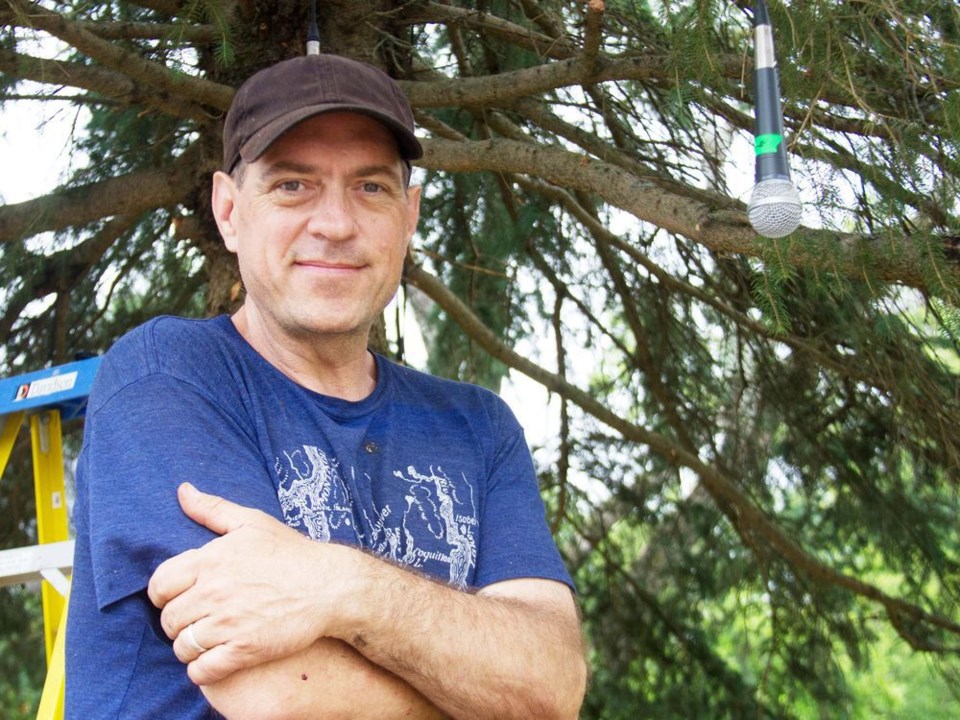SOUTH RIVER — Matt Rogalsky has spent most of his life up in a spruce tree outside the New Adventures in Sound Art (NAISA) gallery.
Covered in sap and twigs, he hangs eight microphones in the tree. His art installation, Octet, reverses the microphones to play sounds of birds captured by William W.H. Gunn.
A play on words for a group of singers, Octet documents birds singing almost as if they are the performers, Rogalsky says.
“These are commonly used vocal microphones that you would see on stage anywhere for human singers. So I've got eight of them suspended in the tree,” he says.
Rogalsky’s work will be one of the first installations featured as part of the reopening of NAISA, a not-for-profit art gallery based in South River that focuses on the medium of sound for art pieces.
The bird sounds have been slowed down by 80 per cent to allow the listener to hear them in a new way. First displayed in 2016, the sounds are on a continuous loop when the gallery is open.
Rogalsky is researching Gunn’s work with his wife, Laura Jean Cameron. Gunn, a bird expert, captured the sounds from the Almaguin Highlands and Algonquin Park areas in the early 1950s. Rogalsky says the songs have been isolated and removed from their environment into a new space.
He says one of the tools Gunn used to capture the sounds is a parabolic reflector, a cone-shaped device around a microphone that can capture a sound focused in front of it, while virtually eliminating sounds around it.
“With the parabolic reflector, you're really kind of reducing your listening field to just the focus of interest,” Rogalsky says.
“It's great to record pristine examples of bird calls in this way, but you ... just have to remember that it's a process of exclusion as much as trying to document something wonderful.”
Rogalsky is of “settler heritage” and says he hopes people listen to the sounds instead of trying to take something away from them in what he calls “settler listening.”
“I guess it comes from my own thinking more and more lately about listener positionality,” Rogalsky says. “It's exploring different modes of listening and what does it mean to listen to it in an Indigenous way or in a settler way. What are the subtleties of the ways that we've been taught to listen? What are the implications? So, I've been pondering that more for myself, because I've been a lifelong listener.”
He says he has always been fascinated with sounds.
“I have strong sound memories going back to being maybe two years old. As a little kid, we had simple things around the house like a cassette recorder and some things that were my dad’s that I was able to play with. Basically, those are my first experiments” with sound art, he says.
NAISA artistic director Darren Copeland says Rogalsky's installation is one piece that visitors can interact with, without having to touch it in order to comply with COVID-19 regulations.
They also have looked at ways of moving pieces outdoors so people can view them safely.
Adapting to the new protocols is almost like starting the business again to let people know it’s safe to come to view the artwork. They also have begun to focus more on online content.
“We need to find a way to reconnect now that we're opening. It’s almost like starting from scratch,” Copeland says. “This is a matter of people trusting me to go into places again and experience culture and stimulate their mind.”
Rogalsky says he’s excited for the opportunity. “It's exciting to be able to put up a piece and have it in one place for a long period of time. It's interesting to see how it evolves in place and come back to it over time.”
Octet will be on display at NAISA from now until Aug. 17.
Mackenzie Casalino is a Local Journalism Initiative reporter withThe North Bay Nugget.
Local Journalism Initiative reporters are funded by the Government of Canada.



